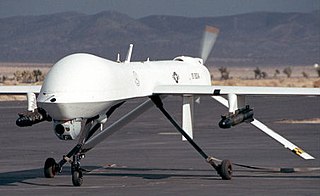
Military robots are autonomous robots or remote-controlled mobile robots designed for military applications, from transport to search & rescue and attack.
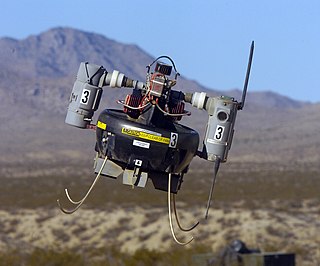
A micro air vehicle (MAV), or micro aerial vehicle, is a class of miniature UAVs that has a size restriction and may be autonomous. Modern craft can be as small as 5 centimeters. Development is driven by commercial, research, government, and military purposes; with insect-sized aircraft reportedly expected in the future. The small craft allows remote observation of hazardous environments inaccessible to ground vehicles. MAVs have been built for hobby purposes, such as aerial robotics contests and aerial photography.

Swarm robotics is an approach to the coordination of multiple robots as a system which consist of large numbers of mostly simple physical robots. It is supposed that a desired collective behavior emerges from the interactions between the robots and interactions of robots with the environment. This approach emerged on the field of artificial swarm intelligence, as well as the biological studies of insects, ants and other fields in nature, where swarm behaviour occurs.

An unmanned ground vehicle (UGV) is a vehicle that operates while in contact with the ground and without an onboard human presence. UGVs can be used for many applications where it may be inconvenient, dangerous, or impossible to have a human operator present. Generally, the vehicle will have a set of sensors to observe the environment, and will either autonomously make decisions about its behavior or pass the information to a human operator at a different location who will control the vehicle through teleoperation.

The Multi-Mission Unmanned Ground Vehicle, previously known as the Multifunction Utility/Logistics and Equipment vehicle (MULE), was an autonomous unmanned ground combat vehicle developed by Lockheed Martin Missiles and Fire Control for the United States Army's Future Combat Systems and BCT Modernization programs. The last component of the program was canceled in July 2011.

The Foster-Miller TALON remotely operated vehicle is a small, tracked military robot designed for missions ranging from reconnaissance to combat.

A mobile robot is a robot that is capable of locomotion. Mobile robotics is usually considered to be a subfield of robotics and information engineering.

The XM1216 Small Unmanned Ground Vehicle (SUGV) is a Future Combat Systems specific, man packable version of the iRobot's PackBot.
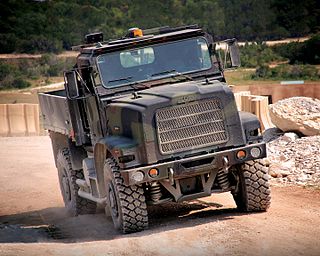
TerraMax is the trademark for autonomous/unmanned ground vehicle technology developed by Oshkosh Defense. Primary military uses for the technology are seen as reconnaissance missions and freight transport in high-risk areas so freeing soldiers from possible attacks, ambushes or the threat of mines and IEDs. The technology could also be used in civilian settings, such as autonomous snow clearing at airports.
Squad Mission Support System is an unmanned all terrain wheeled vehicle developed by Lockheed Martin.
Vehicle Research and Development Establishment (VRDE) is a laboratory of the Defence Research & Development Organization (DRDO) located in Vahannagar. its primary function is research and development of various light tracked, wheeled & specialised vehicles for defence applications.

Guardium, developed by G-NIUS, is an Israeli unmanned ground vehicle (UGV) used to combat and guard against invaders along Gaza's border. It started off as a joint program between Israel Aerospace Industries and Elbit Industries and is now being used by Israeli forces. It can be used in either tele-operated or autonomous mode. Both modes do not demand human interaction for the vehicle to work; thus, giving the operator full audio and visual of the vehicle's surroundings at all times. Both modes of operation make it possible for the Israeli soldiers to fight off any attacker without actually having to risk their lives. When working in groups the vehicles are able to work together and cooperate within the network. The more unmanned ground vehicles out patrolling the area the less human resources needed while also guaranteeing a highly efficient deterrence whenever it is around. The joint program was terminated in April 2016, but the vehicle will remain in service with the Israel Defense Forces.
The following outline is provided as an overview of and topical guide to robotics:
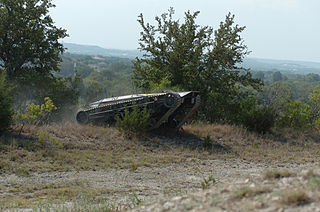
The Ripsaw is a developmental unmanned light tank designed and built by Howe & Howe Technologies for evaluation by the United States Army.
The Modular Advanced Armed Robotic System (MAARS) is a robot that is being developed by Qinetiq. A member of the TALON family, it will be the successor to the armed SWORDS robot. It has a different, larger chassis than the SWORDS robot, so has little physically in common with the SWORDS and TALON robots.

Robotnik Automation is a company specialized in robot product development and robotics R&D projects.
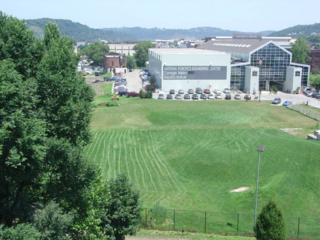
The National Robotics Engineering Center (NREC) is an operating unit within the Robotics Institute (RI) of Carnegie Mellon University. NREC works closely with government and industry clients to apply robotic technologies to real-world processes and products, including unmanned vehicle and platform design, autonomy, sensing and image processing, machine learning, manipulation, and human–robot interaction.
UGV Interoperability Profile , Robotics and Autonomous Systems – Ground IOP or simply IOP was originally an initiative started by the United States Department of Defense (DoD) to organize and maintain open architecture interoperability standards for Unmanned Ground Vehicles (UGV). A primary goal of this initiative is to leverage existing and emerging standards within the Unmanned Vehicle (UxV) community such as the Society of Automotive Engineers (SAE) AS-4 Joint Architecture for Unmanned Systems (JAUS) standard and the Army Unmanned Aircraft Systems (UAS) Project Office IOPs.
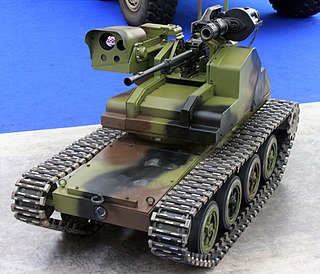
Unmanned ground vehicle Miloš, called Little Milosh, is an unmanned ground vehicle (UGV) developed by the Military Technical Institute Belgrade, following the development of Unmanned ground vehicle Milica in 2009. UGV Miloš is in serial production and first customer are Serbian Armed Forces.














